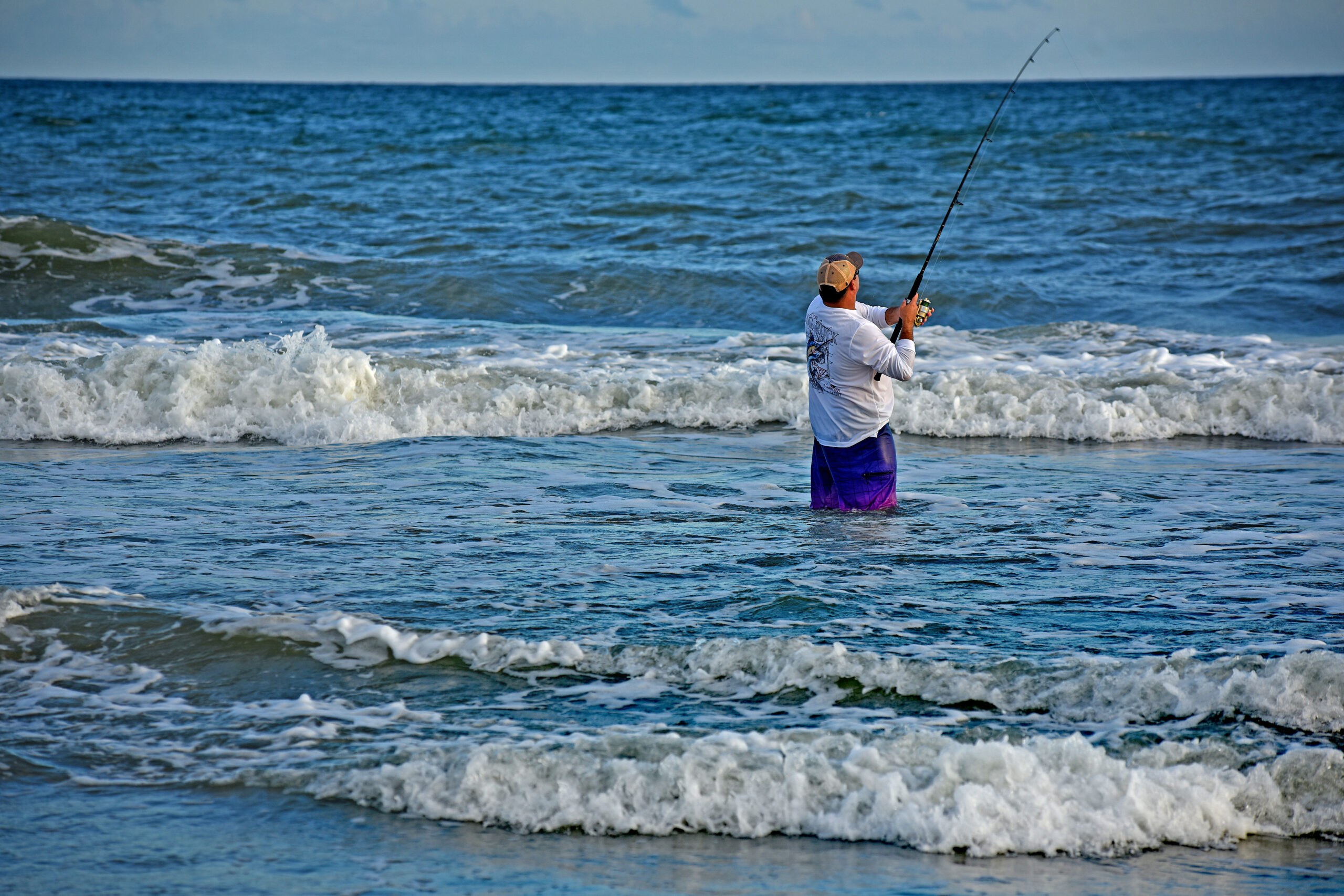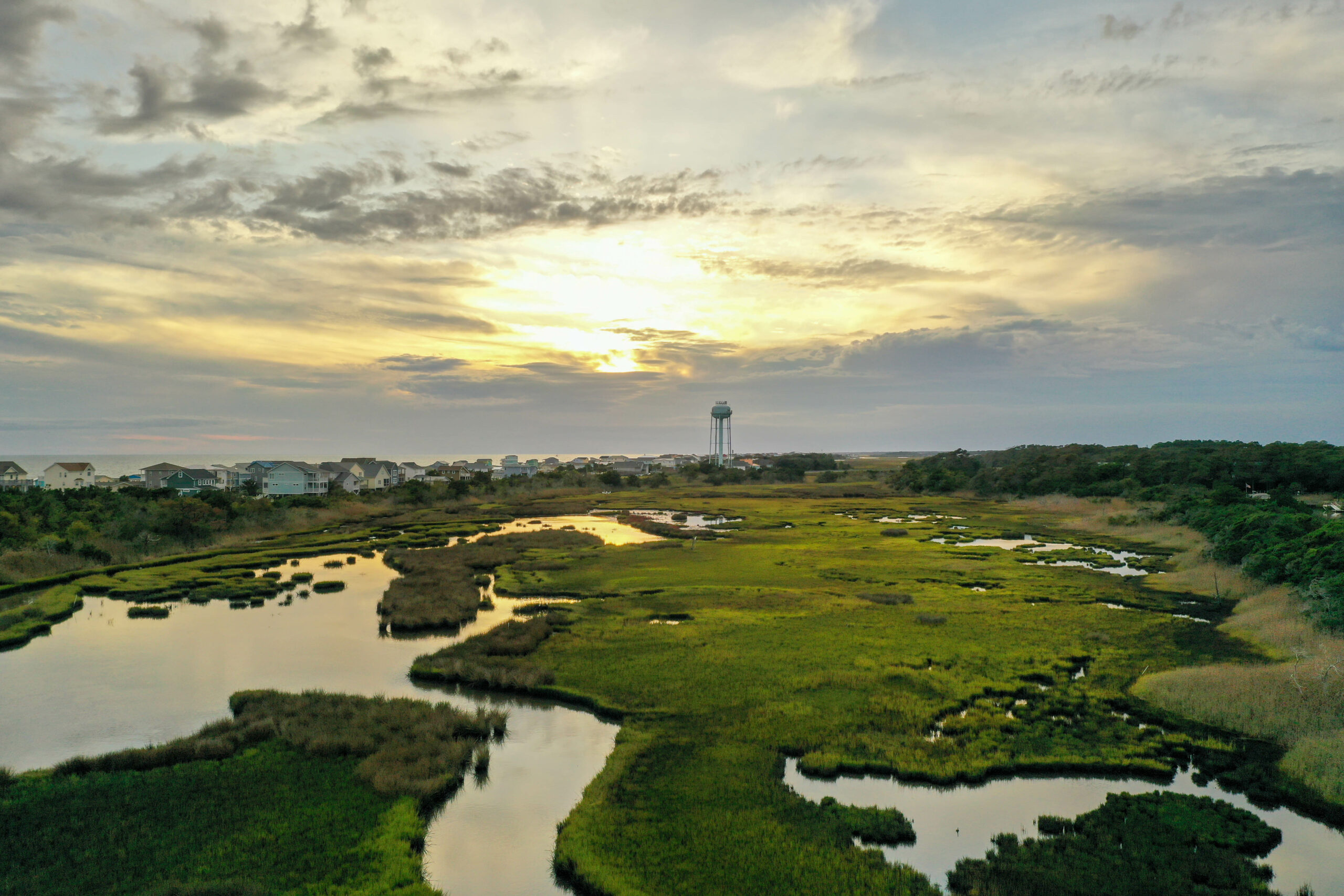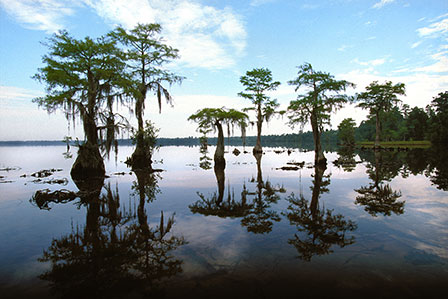Oyster Metrics: Reef Research Identifies Habitat
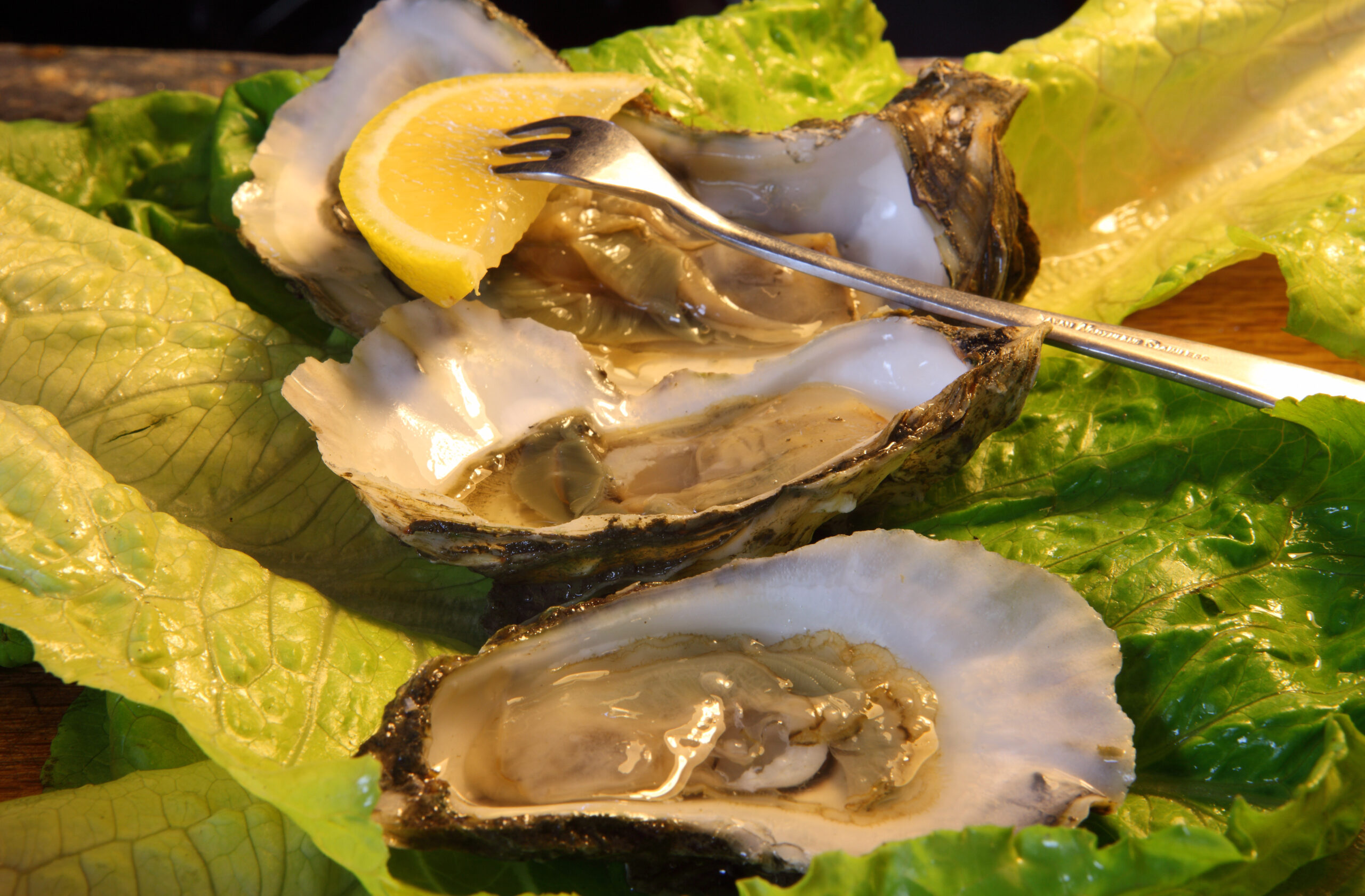
On the edge of Masonboro Sound near Wilmington, researcher Martin Posey stands in ankle-deep mud near an oyster reef.
He bends over the created reef and marvels at the new oyster larvae, also called spat.
“I see a lot of new spat,” says Posey, chair of the University of North Carolina Wilmington Department of Biology and Marine Science. “We are measuring the number of live oysters, their size and biomass, as well as the associated fish that use the reef during high tide.”
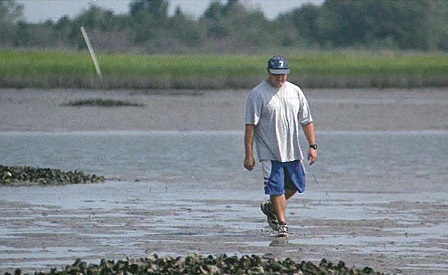
The measurement of oyster populations on intertidal and shallow subtidal reef restoration projects is part of a North Carolina Sea Grant study. By establishing standardized measurements for oyster reefs, fishery managers, researchers and restoration practitioners will be able to compare projects and answer critical questions about restoration efforts.
This project uses standardized performance metrics to assess the oysters and associated reef animals on created reefs, Posey explains. The most commonly used metrics for success of a created oyster reef are fishery yield measures, including the number of marketable oysters and oyster biomass.
“Preliminary data shows significant variability in oyster densities on created reefs in comparison to natural reefs, with reefs at some sites being similar and others showing differences,” Posey says.
The project — which is being conducted by Posey, along with UNCW colleague Troy Alphin and graduate student Ted Wilgis — involves comparing eight natural reefs to 13 created intertidal and shallow subtidal reefs. Built by the N.C. Coastal Federation and the N.C. Division of Marine Fisheries (DMF), the reefs are along the state’s central and southeastern coast.
“One of the greatest problems in restoring oyster reefs has been the uncertainty regarding their success,” Alphin says. “In some areas, restoration efforts have been plagued by the lack of oyster spat, reflecting the degree to which oyster populations have already declined. In other areas, there is a lack of suitable substrate for larval settlement or continued problems with water quality conditions and high disease prevalence.”
STATE’S NATIVE OYSTER
The oyster restoration projects focus on the eastern oyster, or Crassostrea virginica, recognized as an important fishery in North Carolina and other mid-Atlantic states.
During the peak of the state’s oyster industry in the late 1800s, 1.8 million bushels of oysters per year were harvested.
Around that time, schooners from outside North Carolina introduced oyster dredges and longer, sturdier tongs into the local oyster industry. Despite later attempts to restrict dredging, most of the damage to oyster beds had already occurred by 1910, according to DMF.
By the 1960s, ecological changes began affecting the oyster industry, including polluted waters.
“The value of oyster landings in the state peaked in 1987 at just short of $2.9 million, and dropped off shortly after that, reaching a low point 10 years ago,” according to a DMF report.

In recent years, oyster landings, which were valued at around $2.2 million in 2006 by DMF, have recovered moderately despite problems with diseases.
“Dermo (Perkinsus mnrinus) infections continue to persist in all areas, but mortality rates have been significantly reduced in recent years due to less favorable environmental conditions for the parasite,” a DMF stock status report explains. Isolated cases of MSX — a parasite that typically thrives in cooler waters north of North Carolina — have been reported.
“Landings have responded accordingly with the most notable development being the return of a small but viable fishery in Pamlico County,” according to DMF. “However, oysters continue to be highly vulnerable to overfishing because disease, water quality or low dissolved oxygen and habitat impacts can significantly reduce population levels in a matter of months.”
As part of the Fisheries Reform Act of 1997, DMF adopted a fisheries management plan (FMP) for oysters in August 2001. The first FMP amendment for oysters was approved in 2003 to change the criteria for the designation of hand-harvest areas. An update of the oyster FMP has been developed and reviewed, with final approval expected in 2008.
“There is a plan to further reduce mechanical harvesting of oysters in bays around the Pamlico Sound,” says Mike Marshall, DMF central district manager.
Also, the plan includes a proposal for DMF and researchers to use standardized metrics.
“It is very important to be able to compare the status of oyster stocks up and down the coast,” Marshall adds. “Managers need to be able to tell if oysters in any region are impacted by disease, overharvesting or loss of habitat.”
OYSTER’S VALUE
The eastern oyster provides many ecological and environmental benefits, including filtering the water. With less turbidity, more light is transmitted through the water, expanding areas of submerged aquatic vegetation (SAV), an important nursery habitat for many species. Because of the lack of seagrass beds from southeastern North Carolina to northern Florida, oysters also represent the dominant structural habitat in the mid-intertidal to shallow subtidal areas along these coasts.
Although there is growing evidence of the potential ecosystem and habitat roles of oysters, the function and direct fishery value of oyster reefs varies with the characteristics of the reef and its adjacent landscape.
In a previous Sea Grant study, Posey and Alphin focused on how the characteristics of intertidal reef morphology and shape affected the habitat value of oyster reefs.
They found that crabs and certain fish used high complexity reefs with numerous crevices more than reefs with fewer crevices. And smaller organisms such as aphipods and shrimp, which are food for larger fish species, used these reefs more than other reef types.
In addition, reef edge affects local currents, as well as the flow of organic matter and the amount of nutrients inside and outside the reefs.
The edge disrupts the flow and filtration, leading to the deposition of organic nutrients in and around the reefs, possibly increasing the amount of food for bottom animals eaten by fish and blue crabs, Posey says.
In an associated reef restoration project, scientists left a channel between the reefs instead of constructing single expansive ones.
They found that more aquatic species used patchy reefs — each of which measured more than five meters in diameter and had channels between them — than a large continuous area of shells, according to Posey.
STATE’S RESTORATION PROJECTS
Restoration of subtidal and intertidal reefs is growing in most U.S. coastal states.
“Current initiatives in the Chesapeake Bay aim to increase oyster stocks by 10-fold over the next 10 years,” Alphin says. “While other states have both state-funded and private shell planting projects underway.”
In North Carolina, DMF has established oyster sanctuaries, management areas and research sanctuaries in partnership with the Coastal Federation, the Nature Conservancy, the N.C. Oyster Hatchery Program and others. All totaled, groups have constructed more than 150 acres of oyster reef. Currently, nine existing oyster sanctuaries are in place in estuarine waters from Dare to Carteret counties, with two more in the planning stages.
Sanctuaries are built on previously viable oyster producing sites by using a combination of natural oyster shell and/or Class B rip-rap marl. These reefs attract native oyster larvae, as well as clams, juvenile finfish, crabs and marine organisms, which in turn attract larger fish, enhancing hook-and-line fishing.
Harvest of oysters and the use of bottom-disturbing gear are prohibited in the sanctuaries, allowing broodstock oysters to develop.
Each oyster produces millions of eggs annually that are carried by currents and tides to surrounding areas. By developing and protecting a broodstock, the availability of robust native oysters in adjacent waters increases.
For the first three weeks of an oyster’s life, it is a free-swimming animal that is carried about by currents. After the third week, the oyster moves to the bottom and attaches itself to a clean, hard surface to survive.
During the summer months, DMF plants shell and rock, known as cultch, to provide additional habitat for larval oysters. Large vessels transport the cultch out to a designated site. The shells are either dumped off with a front-end loader or sprayed off with a high power hose. More than 500,000 bushels of cultch are planted annually in the state.
OYSTER RECYCLING
To create sizeable reefs, North Carolina is pooling its resources. In 2003, the state launched an innovative recycling program to collect oyster shells from individuals and businesses and place them back in the water.
A mound of oyster shells placed in brackish or marine water with good tidal flow will quickly become colonized by a multitude of marine organisms. This mound or reef helps to produce oysters.
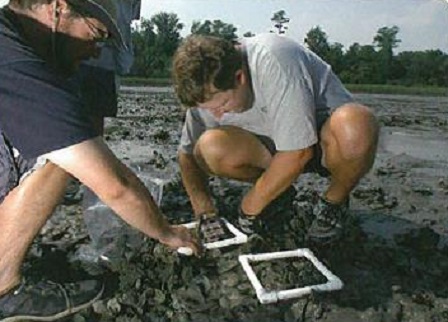
“Oyster conservation is important because of benefits on multiple fronts to commercial fishermen, shucking houses and the seafood industry, as well as environmental factors — water filtration and habitat creation,” says Marc Turano, North Carolina Sea Grant mariculture and blue crab specialist. “Efforts to understand reef function can ultimately ‘shape’ how and where we construct reefs during restoration efforts.”
To improve future oyster sanctuaries, the South Carolina Sea Grant Consortium, Coastal Carolina University, The Nature Conservancy and the S.C. Department of Natural Resources sponsored a regional Oyster Restoration Workgroup in 2004. Participants identified key monitoring metrics that should be included in restoration projects.
The meeting resulted in several studies, including the North Carolina Sea Grant project.
“Aside from the establishment of a healthy population of oysters, consensus on what constitutes a successful reef restoration project currently does not exist,” Posey says.
Their results will be compared to other projects adopting the same metrics and sampling protocols, allowing regional comparison of reef function and methodological success.
Researchers also will be looking at the differences between reefs that were established through simple shell placement and adjacent reefs established with shells seeded with live oysters.
“Seeding is a labor-intensive approach, whose cost-effectiveness has not been well tested,” Posey says.
The scientists are measuring the shell height of each oyster, as well as the thickness of the shell layer. “An insufficient underlying bed may allow the restored reef to sink before live oysters have been established enough to keep up with sedimentation and burial,” Posey says. “And too much shell base may raise the substrate and put the reef heights in intertidal beds beyond optimum levels.”
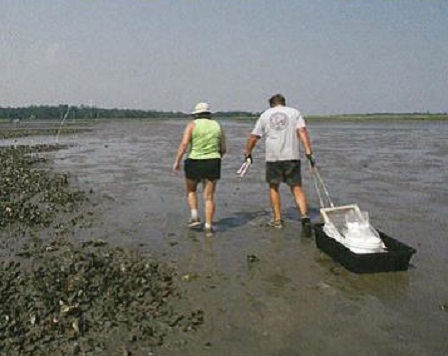
Because of the scarcity of shell for restoration projects, there is a desire to place the minimum amount of shell in areas that will allow a high likelihood of success, Posey explains.
“Few studies have examined variation in the success of intertidal reefs built with varying shell bed depth,” he adds. “Enclosures of reefs within a marsh or channel area may promote larval retention and increase long-term recruitment success.”
As part of the Sea Grant research, Wilgis is focusing on fish utilization of reef habitats by comparing nekton on artificial reefs to natural reefs. Nekton are animals that move freely in the water column.
“By using traps, nets and visual observations, we are assessing the number of fish, shrimp and crab utilizing these reefs,” Wilgis says. ‘This is an important project because so much effort has been put into building reefs. We need to properly evaluate the projects and share the results with restoration practitioners, researchers, government agencies and shellfish growers and harvesters.”
“The ultimate goal of these efforts is to increase oyster populations and habitats,” Alphin says.” We need to know what characteristics are most important for the long-term survival of oyster reefs in our coastal waters.”
VOLUNTEERS COLLECT OYSTER DATA
When researchers collect data on oyster larvae settlement throughout coastal North Carolina, the effort is labor intensive.
To gather more data by hand, North Carolina Sea Grant researchers Martin Posey and Troy Alphin have recruited 66 volunteers along the North Carolina coast, from Brunswick to Hyde counties. Volunteers include concerned citizens, school groups and others, including the N.C. Aquarium at Pine Knoll Shores.
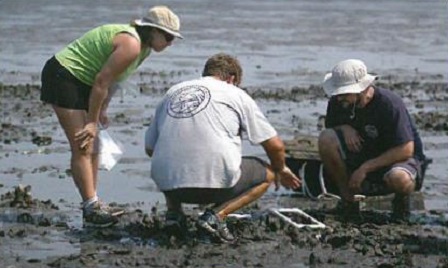
The University of North Carolina Wilmington scientists provide racks and ceramic tile for volunteers to deploy off their docks to serve as surrogate oyster shells. Every few weeks the volunteers pull the tiles and measure the number of settled oysters, average temperature and salinity.
“You have to own or have access to a dock to participate in the project,” Alphin explains.
At the Pine Knoll Shores aquarium, the project will double as an educational tool to demonstrate spat collection to the public and raise awareness about the UNCW study, says Pat McNeese, research coordinator.
By collecting year-round data on oyster settlement and density along the state’s coast, researchers will identify the time of year oyster spat, also known as larvae settle. The additional environmental data — including temperature salinity and rainfall — will allow scientists to compare oyster settlement to local conditions, and look for potential correlations.
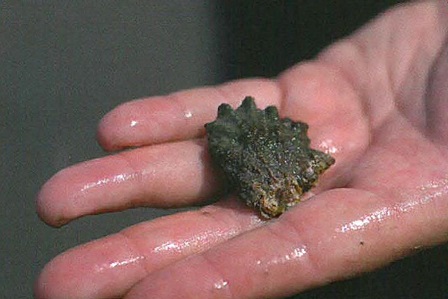
“If you know the peak time of spat settlement, you can target cultch placement — loose oyster shells that oyster larvae settle on — to more closely coincide with larval settlement,” Alphin adds.
“If spat set in October, you don’t want to put cultch out in December. But you might want to do your shell planting later in the summer or supplement existing shell plantings during periods when spat have been shown to settle.”
This is one of the first efforts to coordinate sampling for oyster larvae up and down the North Carolina coast. Marc Turano, Sea Grant mariculture specialist, is working with volunteers at northern coastal sites.
“We have been impressed with the response and dedication of the volunteers” Alphin says. “With their help, we will be providing critical information for oyster management in restoration projects.”
To make it easier for volunteers to download data, Alphin and Posey are creating a Web site.
“We will be able to post data from all locations for viewing on the site,” Alphin says.
For more information about volunteering, contact Troy Alphin at 910-962-2395 or alphint@uncw.edu.
This article was published in the Winter 2008 issue of Coastwatch.
For contact information and reprint requests, visit ncseagrant.ncsu.edu/coastwatch/contact/.
- Categories:
